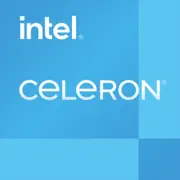Intel Celeron G5920

Intel Celeron G5920: A Budget Processor for Basic Tasks
Exploring the capabilities, compatibility, and use cases of the Comet Lake dual-core chip
1. Key Specifications: Architecture, Process Node, and Performance
Comet Lake Architecture
The Celeron G5920 belongs to the Comet Lake-S family, introduced by Intel in 2020. It is a 10th generation processor built on the outdated 14nm process node. Despite the repeated use of the same process, Intel optimized the architecture to boost clock speeds — the G5920 has a base frequency of 3.5 GHz, and it lacks Turbo Boost.
Key Features:
- 2 cores / 2 threads — the minimum configuration for modern tasks.
- L3 Cache — 2 MB — sufficient for simple applications, but not enough for advanced multitasking.
- Integrated UHD 610 graphics — supports 4K via HDMI 1.4 but is not suitable for gaming.
- TDP 58 W — moderate power consumption, but higher than some competitors (for example, Athlon 3000G has a TDP of 35 W).
Performance in Tests:
- Geekbench 6: 749 (Single-Core), 1248 (Multi-Core). For comparison: the Pentium Gold G6405 (2C/4T) scores around ~900/1800.
- Cinebench R23: Expected results are around 600-700 points in multi-threading.
Practical Example: In an office PC with an SSD, the Celeron G5920 handles Word, Excel, and 10+ Chrome tabs satisfactorily, but launching Zoom alongside the browser may result in some stuttering.
2. Compatible Motherboards
LGA 1200 Socket and Chipsets
The processor uses the LGA 1200 socket, which limits motherboard options to these formats:
- H410 / B460 / H470 / Z490 — for Comet Lake processors.
- H510 / B560 / H570 / Z590 — compatible after a BIOS update, but not all manufacturers provide support.
Selection Recommendations:
- Budget Option: ASUS Prime H410M-K — a basic board with HDMI and USB 3.2.
- For Upgrading: MSI B560M PRO-VDH — supports PCIe 4.0 and faster memory (if planning to update the CPU in the future).
Limitations:
- H410/B460 chipsets do not support overclocking (though this is irrelevant for Celeron).
- Maximum RAM speed — DDR4-2666 (on H510/B560, it can go higher, but the CPU limits the frequency).
3. Supported Memory
Memory Type: DDR4-2666 (officially). DDR5 and LPDDR4x are not supported.
Configurations:
- Dual-channel mode — essential for boosting integrated graphics performance.
- Maximum capacity — 128 GB (but for Celeron, 8-16 GB is sensible).
Example Configuration: 2 x 4 GB DDR4-2666 modules (e.g., Kingston Fury Beast) will provide a 15-20% boost in gaming and video rendering compared to single-channel mode.
4. Power Supply Recommendations
Power Calculation:
- CPU TDP — 58 W.
- Considering the motherboard, SSD, memory, and cooler: 150-200 W.
- If adding a graphics card (e.g., GTX 1650), a power supply of 350-400 W is required.
Tips:
- Choose models with 80 Plus Bronze certification (Be Quiet! System Power 9, Corsair CV450).
- Avoid cheap noname power supplies — they can perform erratically even under low load.
5. Pros and Cons of Celeron G5920
Pros:
- Low price (~$50-60) — one of the most affordable LGA 1200 processors.
- Energy efficiency — suitable for compact PCs and passive cooling systems.
- Integrated graphics — does not require a discrete graphics card for video output.
Cons:
- 2 cores / 2 threads — insufficient for parallel tasks (streaming, video editing).
- Weak GPU — UHD 610 lags behind Vega 3 (Athlon 3000G) in gaming.
- Limited upgrade potential — upgrading to a Core i3/i5 would require changing the cooler due to increased TDP.
6. Use Cases
Gaming
- What works: Minecraft, Dota 2, CS:GO at low settings (720p, 30-40 FPS).
- With a discrete graphics card: GTX 1050 Ti or RX 6400 — the processor will become a "bottleneck" in modern titles (Cyberpunk 2077, Horizon Zero Dawn).
Work Tasks
- Suitable for: office programs, email, video calls.
- Not suitable for: 4K editing, 3D modeling, working in Blender.
Multimedia
- Pros: Hardware video decoding for VP9 and H.265 — 4K viewing on YouTube.
- Cons: No AV1 support — may require an upgrade for future streaming services.
7. Comparison with Competitors
AMD Athlon 3000G (Zen, 14nm)
- 2C/4T, Vega 3, TDP 35 W.
- Geekbench 6: ~700 (SC), ~1400 (MC).
- Pros: Multi-threading, better graphics.
- Cons: AM4 socket is becoming outdated, harder to find new motherboards.
Intel Pentium Gold G6405 (Comet Lake)
- 2C/4T, UHD 610, TDP 58 W.
- Geekbench 6: ~900 (SC), ~1800 (MC).
- Pros: Hyper-Threading, starting price of $70.
Conclusion: The Celeron G5920 falls short against the Athlon 3000G in multitasking and graphics but wins on price. For gaming, it's better to choose the Athlon, while for office use, the Celeron is suitable.
8. Assembly Tips
- Motherboard: Don’t overpay for Z490 — H410 is sufficient.
- Storage: An SSD is essential (Crucial BX500 240 GB).
- Cooling: The boxed cooler is adequate, but for quiet operation, replace it with a Deepcool GAMMAXX 200T.
- Case: Mini-ITX (Fractal Design Core 500) for a compact media center.
9. Final Verdict: Who Is the Celeron G5920 For?
This processor is ideal for:
- Budget office PCs — if you need a computer for Word and browsing.
- Home theaters — due to 4K decoding capabilities.
- Entry-level servers — for file storage or VPN needs.
Why this one? Low price, minimal power consumption, and sufficient performance for basic tasks. However, for gaming, video editing, or AI work, it's better to consider the Pentium Gold or Ryzen 3.
Basic
CPU Specifications
Memory Specifications
GPU Specifications
Miscellaneous
Benchmarks
Compared to Other CPU
Share in social media
Or Link To Us
<a href="https://cputronic.com/cpu/intel-celeron-g5920" target="_blank">Intel Celeron G5920</a>